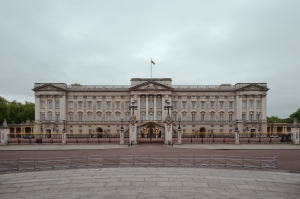Saint Martin’s Churchyard, Bladon 2014
© Leslie Hossack
Winston Leonard Spencer Churchill was born November 30th 1874 at Blenheim Palace. He died 90 years later at his home in London, on January 24th 1965.
The year 2015 marks the 50th anniversary of the death of Sir Winston Churchill. After a state funeral in London, Sir Winston was buried on January 30th 1965 in the Churchill family plot in Saint Martin’s Churchyard in Bladon, just a mile from where he was born. On the day of his funeral, flowers arrived in the churchyard for the private family graveside service. In the pamphlet Sir Winston Churchill and the Bladon Connection, published by the Parish Church of St. Martin, Bladon, it is noted that the Queen’s flowers were white and exquisite, and written in her own hand were the words: “Winston Churchill, From the Nation and Commonwealth, In Grateful Remembrance, Elizabeth R.” Lady Churchill’s flowers are described as glorious red, accompanied by a note reading: “To Winston with all my love, Clemmie.”
And so, after a lifetime of pomp and circumstance, Winston was quietly laid to rest in a tiny plot behind Saint Martin’s Church. Here, Clemmie said goodbye to Winnie: husband, father, grandfather; cavalry officer, infantry man, military strategist; reporter, author, orator; politician, parliamentarian, prime minister; statesman, Nobel laureate, Knight of the Garter; painter, brick layer, world traveller. Here, in a country churchyard, Clementine bade farewell to Winston, the man who loved: dogs, cats and horses; exotic butterflies, ornamental fish and roses; Cuban cigars, fine food and Pol Roger champagne; afternoon naps, hot baths and late nights; Blenheim Palace, Chartwell Manor and the Houses of Parliament; hats of all kinds, bespoke tailoring and polka dot bow ties; and the man that many credit with saving the world from Nazi tyranny.
The image featured above is part of the limited edition collector’s portfolio created by Leslie Hossack to mark the 50th anniversary of the death of Sir Winston Churchill. She presents locations that chart Churchill’s personal and political life, from his birth at Blenheim Palace in 1874 until his death in London in 1965. THE CHURCHILL PHOTOGRAPHS are part of Hossack’s larger body of work that explores Nazi architecture in Berlin, Stalinist structures in Moscow, contested sites in Jerusalem, a Cold War bunker in Ottawa, NATO’s Headquarter Camp in Kosovo, and buildings linked to the Japanese Canadian internment during World War II.
To view more photographs, please visit Leslie’s website. lesliehossack.com


















